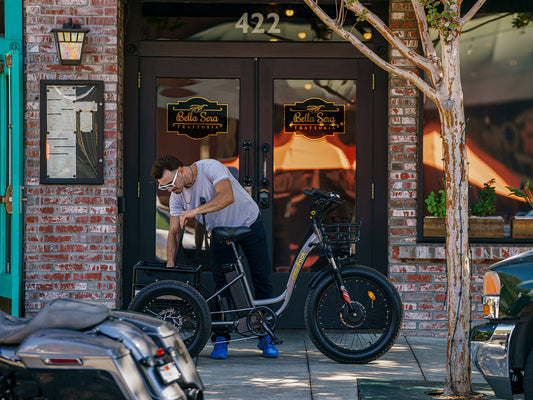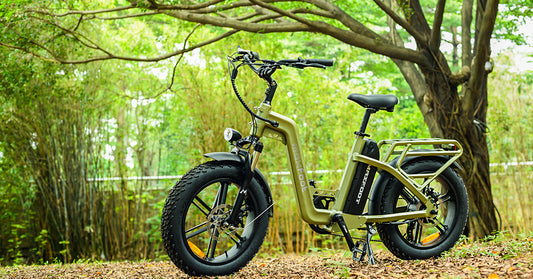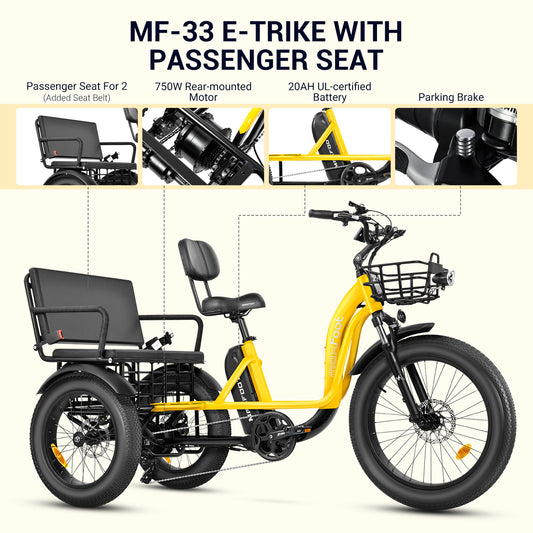Cycling is an exhilarating way to explore the outdoors, stay fit, and reduce your carbon footprint. As a beginner, there’s no better time than now to hop on a bike and experience the freedom that comes with riding.
However, before you begin your first ride, it is essential to prepare adequately. This comprehensive guide will walk you through the process, ensuring a safe and enjoyable experience.

1. Choose the Right E-Bike
The first step to getting ready for your first electric bike ride is selecting the appropriate bike. E-bikes come in various styles, such as commuter, mountain, cargo, and folding bikes. Consider factors like your preferred terrain, riding style, and budget when selecting your e-bike.
Also, ensure that the bike fits you properly. You should be able to touch the ground with your feet when seated and have a slight bend in your elbows when gripping the handlebars. Similarly, the height should be such that your knee gets slightly bent when pedaling. A high or low height can cause knee injuries. A well-fitted e-bike will make your ride more comfortable and reduce the risk of injury.
For seniors, who aren’t comfortable riding a two-wheeler that can difficult for them to balance. They can try buying electric tricycles, or Maxfoot electric trikes. These fat tire tricycles not only make it easy to balance but also offer more traction and grip on the road.

2. Familiarize Yourself with the E-Bike's Features
E-bikes have unique features compared to traditional bicycles, such as a motor, battery, and throttle. Review the user manual and familiarize yourself with these components, their functions, and how to operate them.
Learn how to switch between different assistance levels and understand how the throttle and pedal-assist systems work.
You need to be aware of your e-bike's range i.e. the distance it can cover on a single battery charge. The range will depend on factors like battery capacity, terrain, and rider weight. However, knowing your e-bike's average range will help you plan your routes and avoid running out of battery power during your ride.
3. Inspect Your Vehicle Before Adventure
Make sure the battery is fully-charged or charged enough to take you to your desired destination. Similarly, clean the bicycles, and lubricate its chain. Also, keep an eye on the tire pressure, they need to be fully inflated before you start your adventure.

4. Invest in Essential Safety Gear
Safety should always be a top priority when cycling and e-bikes are no exception. Invest in quality safety gear, including:
- Helmet: Awell-fitted helmet is crucial for protecting your head in case of an accident. Choose a helmet specifically designed for cycling, which has adequate ventilation and adjustable straps.
- Lights: Most e-bikes do have lights. However, if they don’t, doequip your e-bike with front and rear lights to enhance visibility, especially when riding in low-light conditions or at night.
- Reflective gear: Wear reflective clothing or accessories to increase your visibility to other road users.
5. Plan Your Route
Before embarking on your first e-bike ride, plan your route in advance.
Choose a route with minimal traffic, well-maintained roads, and relatively flat terrain for a more enjoyable and safer experience. As you gain confidence and experience, you can gradually explore more challenging routes.
Apps like Google Maps, Komoot, Apple Maps, and Strava offer cycling-specific navigation and can help you find suitable routes in your area.
Again, don't forget to consider your e-bike's range when planning your route to avoid running out of battery power.
6. Familiarize Yourself with Local Regulations
E-bikes are subject to specific rules and regulations, unlike other vehicles. Their regulation may vary by location. So, research local laws to understand where you can ride your e-bike, any speed limits, and whether you need specific permits or licenses.
7. Practice Riding Skills and Etiquette
Instead of directly venturing out in the city on your first e-bike ride, practice riding skills in a safe, traffic-free environment like an empty parking lot or quiet neighborhood street.
Focus on mastering essential skills such as starting, stopping, turning, and shifting gears. Familiarize yourself with the e-bike's acceleration, braking, and handling to build confidence and control.
Additionally, learn about cycling etiquette to ensure a positive experience for yourself and those around you. Some essential cycling etiquette rules include:
- Riding on the right side of the road or designated bike lanes, moving with the flow of traffic.
- Obeying traffic signals and signs, just like other road users.
- Using hand signals to communicate your intentions to turn or stop.
- Being cautious when overtaking other cyclists or pedestrians, announcing your presence with a bell or friendly verbal cue.
- Avoiding headphones or engaging in other distractions while riding.
8. Carry Emergency Gear
Despite your best efforts, emergencies can still occur during your e-bike ride. Be prepared by carrying a small repair kit containing essentials like a multi-tool, tire levers, a spare inner tube, and a portable pump.
Also, you need to be aware of basic roadside repair skills, such as fixing a flat tire or adjusting a loose bolt.
It's also a good idea to carry a fully charged mobile phone and have emergency contact information readily available.
If you're riding alone, inform someone (a close friend or family member) of your planned route and expected return time.

9. Dress Appropriately
Wearing comfortable, weather-appropriate clothing will make your e-bike ride more enjoyable. Opt for moisture-wicking, breathable fabrics that help regulate your body temperature.
In colder weather, dress in layers to keep warm and easily adjust to changing conditions. For added comfort during longer riders, you can also wear padded cycling shorts or tights.
10. Stay Hydrated and Energized
Staying hydrated and well-nourished is essential during any physical activity, including e-bike riding. Carry a fully-filled water bottle, and take regular sips throughout your ride.
For longer rides, pack energy-rich snacks like energy bars, fruit, or nuts to help maintain your energy levels.
Final Words
Preparing for your first e-bike ride might seem daunting, but with the right gear, knowledge, and practice, you will be well on your way to enjoying the thrill and freedom that e-biking offers.
We hope that with the steps outlined in this guide, you will be ready to embark on your e-biking journey safely and confidently.




